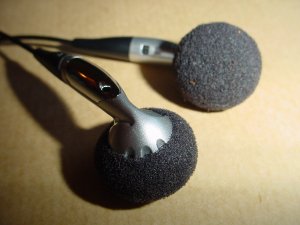What is the Best Earphone for Listening To Music?
Back to Basics
Back to Basics is a monthly column written by Marshall Chasin for the Hearing Review. Permission has been granted to reprint some of these columns in Canadian Audiologist.
 As hearing health care professionals we are always asked, almost as an after-thought as our clients are walking out the door, “what is the best earphone for my MP3 player?” It reminds me of the 1970s police detective show starring Peter Falk called Columbo. Detective Columbo appeared to be an absent minded, rumpled policeman who always said as he was about to leave, “oh… one more question…” and that of course was the most important thing that would later come back to haunt the bad guy. (And for the younger readers, Peter Falk played the grandfather in the Princess Bride).
As hearing health care professionals we are always asked, almost as an after-thought as our clients are walking out the door, “what is the best earphone for my MP3 player?” It reminds me of the 1970s police detective show starring Peter Falk called Columbo. Detective Columbo appeared to be an absent minded, rumpled policeman who always said as he was about to leave, “oh… one more question…” and that of course was the most important thing that would later come back to haunt the bad guy. (And for the younger readers, Peter Falk played the grandfather in the Princess Bride).
So what is the “best” headphone that can be used for listening to music?
The best headphone should have four features:
- A broadband frequency response with a peak in the 2500-3000 Hz region of about 10 dB.
- A good seal to the ear canal.
- An appropriate sensitivity such that with high output levels, the earphone does not clip or distort.
- Must come in the colour red.
Dispensing with the fourth item first, everything is better if it is red; everyone knows that red cars go 37% faster! Let’s dwell on the other three features.
- Upon insertion into the ear canal there will be a slight loss of the natural outer ear acoustic features. This “insertion loss” amounts to about 10 dB in the 2500–3000 Hz region so should be replaced in order to establish a flat, broadband response if measured at the eardrum. Many earphones have peaks in the 2000 Hz region and this is related to the mechanical features of the vibrating diaphragm, but this resonance needs to be slightly higher in order to offset the ear’s natural diffuse field response. Some commercially available earphones for music have a flat response and these would result in a poorer high frequency transmission of the music.
- Some earphones are designed to sit in the opening/concha of the outer ear and while these may feel comfortable, the music is not sealed into the ear. It doesn’t matter whether an earphone sits in the opening of the ear canal or has a stem that is directed towards the eardrum – directionality for higher frequency sound transmission is not issue with closed volumes such as an ear canal. The issue is that it must be noise-excluding. Low frequency room noise can mask out the lower frequency components of the music and force a listener to needlessly turn up the volume control.
- One cannot assume that special engineering care has been taken to ensure that the earphones are not distorting with higher levels from the MP3 player. It is true that many earphones tend to reach their maximum output before volume 10 is achieved on the MP3 player but even if this is the case, distortion should not be heard. This is certainly something that can be checked clinically with a hearing aid test box system. Couple the earphone to the 2 cc HA-1 coupler using putty and manually generate a 1000 Hz stimulus at the highest level that the test system will allow. If there are “additional” resonances at 3000 Hz and 5000 Hz (i.e., odd numbered multiples of 1000 Hz) then this is evidence of peak clipping and distortion. A good earphone will have minimal 3000 Hz and 5000 Hz distortion products due to the 1000 Hz signal. Figure 1 below shows an earphone that has severe peak clipping-related distortion (odd numbered resonances of the 1000 Hz stimulus), also known in the time domain, as a square wave.

Figure 1. Graph showing an earphone with severe peak clipping-related distortion.
Some manufacturers market “kid safe” earphones that prevent outputs in excess of a certain level (e.g., 90 or 95 dB SPL) by simply limiting the output, which creates peak clipping distortion. Others (for example, ETY-Kids safe-listening earphones http://www.etymotic.com/ek5.html) have taken special care to attenuate the input to the earphone, thereby offering safe but high-quality music to the child that can be played for at least 4 hours at maximum volume settings on mp3 players, and without audible distortion.

